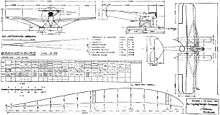Hansa-Brandenburg W.29
The Hansa-Brandenburg W.29 was a German monoplane fighter floatplane which served in the closing months of World War I, from bases on the North Sea coast.
| W.29 | |
|---|---|
 | |
| W.29 of Imperial Japanese Navy | |
| Role | Floatplane fighter |
| Manufacturer | Hansa und Brandenburgische Flugzeug-Werke |
| Designer | Ernst Heinkel |
| First flight | 27 March 1918 |
| Introduction | 1918 |
| Primary user | Kaiserliche Marine |
| Number built | 78 |
It was based on the W.12 biplane that it was designed to replace. The monoplane configuration created less drag, and thus gave greater speed.
Variants
- W.29
- Production aircraft from Hansa und Brandenburgische Flugzeug-Werke.
- Van Berkel W-B
- Licence-production in the Netherlands by Van Berkel's Patent Company Ltd.
- Måke I
- Norwegian Army designation for W.29. Two operated.[1]
- Hanza-shiki suijō teisatsuki
- (ハンザ式水上偵察機, Type Hansa Surveillance Floatplane) built by Nakajima and Aichi
- Orlogsværftet HM.1
- Licence-production in Denmark by Orlogsværftet (Danish Royal Naval Dockyard).[2]
Operators
- KuKLFT - Austria-Hungary placed an order for 25 W.29s, powered by 185 hp (138 kW) Austro-Daimler engines, to be built under license by Ufag at Budapest. One completed by the end of World War I.[3]
- Royal Danish Navy - purchased one W.29 from Germany in 1919, building a further 15 powered by the 150 hp Benz or 160 hp (120 kW) Orlogsværftet O-V six-cylinder inline engine under license at the Orlogsværftet (Danish Royal Naval Dockyard) as the HM.1 from 1921 to 1927, the type remaining in service until 1930, being replaced by the Heinkel HE 8.[2]
- Finnish Air Force Finnish AF did NOT use W.29, but IVL A.22 Hansa, based on W.33.
- Kaiserliche Marine
- Hungarian Soviet Republic ordered production of the W.29 at Ufag to restart. At least two were completed, which together with the single W.29 completed for Austria-Hungary, were operated by the 9th Floatplane Squadron operating from Cspel near Budapest.[3]
- Imperial Japanese Navy - Used as Hanza-shiki suijō teisatsuki(ハンザ式水上偵察機, Type Hansa Surveillance Floatplane) and manufactured by Nakajima Aircraft Company and Aichi Kokuki.
- Norwegian Army received two ex-German W.29s in 1920, using them for support of coastal artillery.[4] The two W.29s, designated Måke I, were transferred to the Royal Norwegian Navy in 1928, along with the army's W.33s and the Coastal Artillery arm.[5]
- A/S Aero
- At least one W.29 is known to have been captured and tested at the MAEE (Marine Aircraft Experimental Establishment) in Felixstowe.[6]
Specifications (W.29)

Hansa-Brandenburg W.29 drawing
Data from Encyclopedia of Military Aircraft,[7] German Aircraft of the First World War[8]
General characteristics
- Crew: 2 (pilot & observer/gunner)
- Length: 9.36 m (30 ft 9 in)
- Wingspan: 13.5 m (44 ft 3 in)
- Height: 3 m (9 ft 10 in)
- Wing area: 32.2 m2 (347 sq ft)
- Empty weight: 1,000 kg (2,205 lb)
- Gross weight: 1,494 kg (3,294 lb)
- Powerplant: 1 × Benz Bz.III 6-cylinder water-cooled in-line piston engine, 112 kW (150 hp)
- Propellers: 2-bladed fixed-pitch propeller
Performance
- Maximum speed: 175 km/h (109 mph, 94 kn)
- Range: 520 km (320 mi, 280 nmi)
- Endurance: ca. 4 hours
- Service ceiling: 5,000 m (16,000 ft)
- Time to altitude: 1,000 m (3,281 ft) in 6 minutes
- 2,000 m (6,562 ft) in 13 minutes
- 2,000 m (6,562 ft) in 23 minutes
Armament
- Guns:
- 1 or 2 × fixed forward 7.9 mm (0.312 in) lMG 08 machine guns
- 1 × 7.9 mm (0.312 in) Parabellum MG14 in rear cockpit
References
- Owers Air Enthusiast September/October 1997, pp. 31, 34.
- Owers Air Enthusiast September/October 1997, p. 30.
- Owers Air Enthusiast September/October 1997, pp. 29–30.
- Owers Air Enthusiast September/October 1997, p. 31.
- Owers Air Enthusiast September/October 1997, p. 34.
- http://www.airwar.ru/enc/fww1/w29.html
- Jackson, Robert (2003). The encyclopedia of military aircraft. Bath: Parragon Pub. ISBN 9780752581309.
- Gray, Peter; Thetford, Owen (1970). German Aircraft of the First World War (2nd ed.). London: Putnam. pp. 75–78. ISBN 0-370-00103-6.
- Gray, Peter; Thetford, Owen (1970). German Aircraft of the First World War (2nd ed.). London: Putnam. ISBN 0-370-00103-6.
- Jackson, Robert (2003). The encyclopedia of military aircraft. Bath: Parragon Pub. ISBN 9780752581309.
- Owers, Colin A. (September–October 1997). "Zeebrugge's Hornets: The Brandendurg Monoplanes: Part One". Air Enthusiast. No. 71. pp. 29–30, 34. ISSN 0143-5450.
This article is issued from Wikipedia. The text is licensed under Creative Commons - Attribution - Sharealike. Additional terms may apply for the media files.